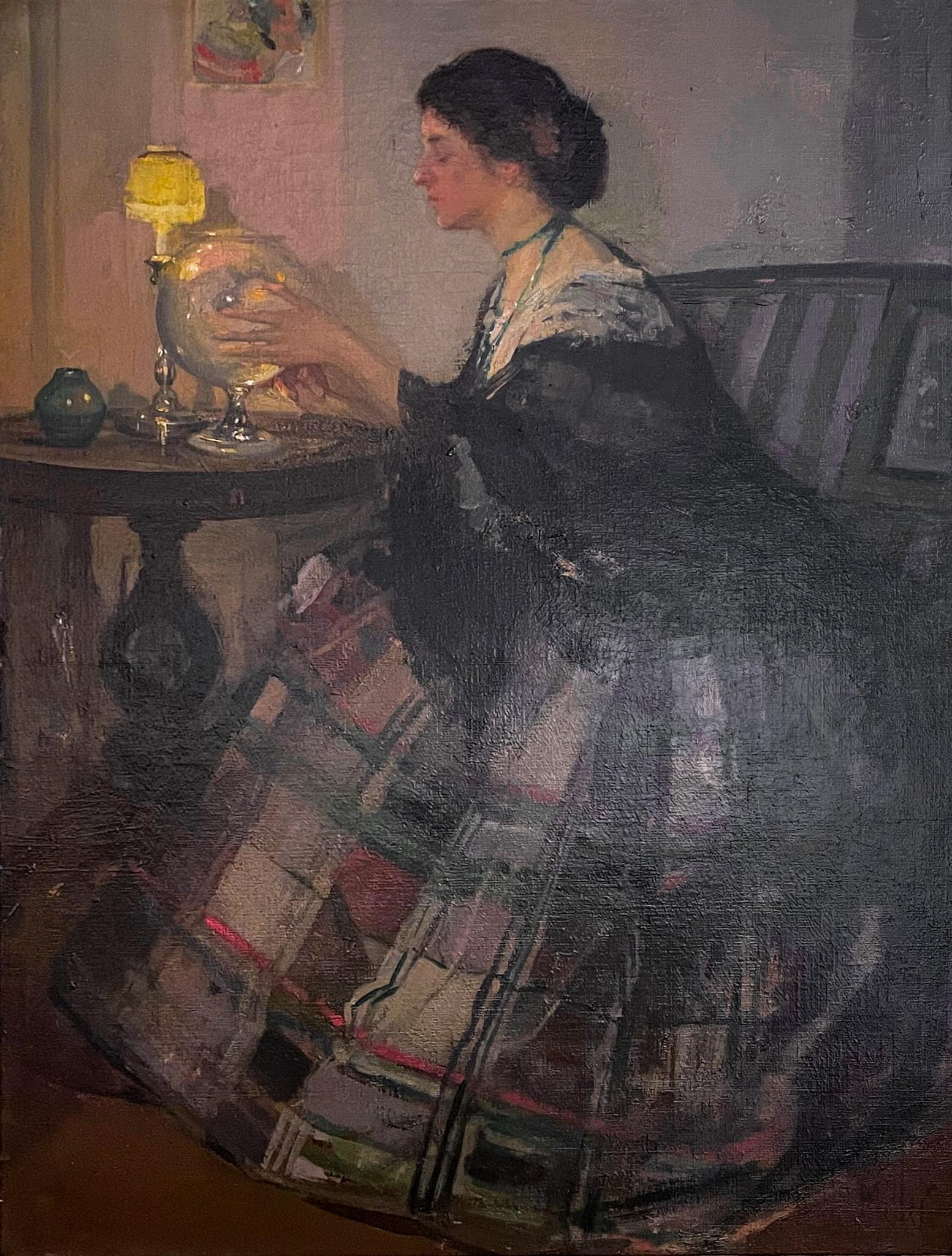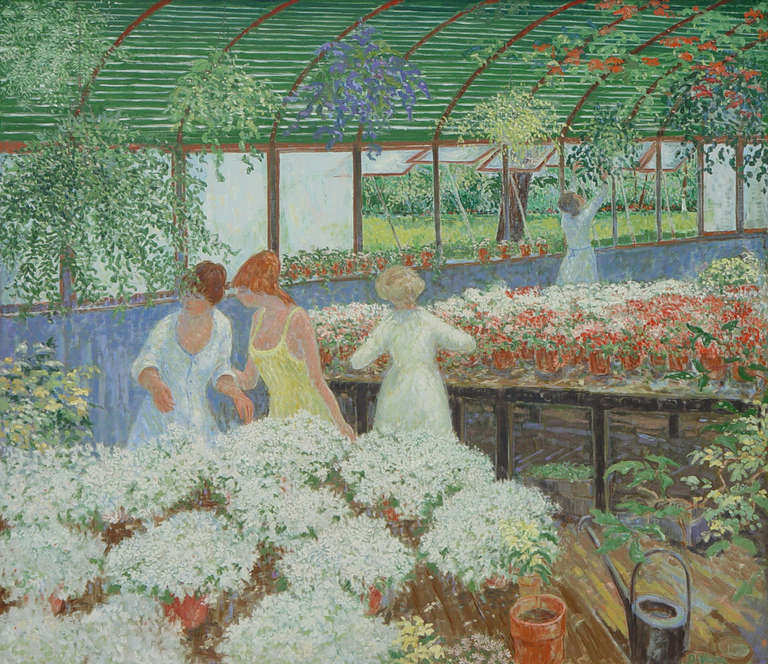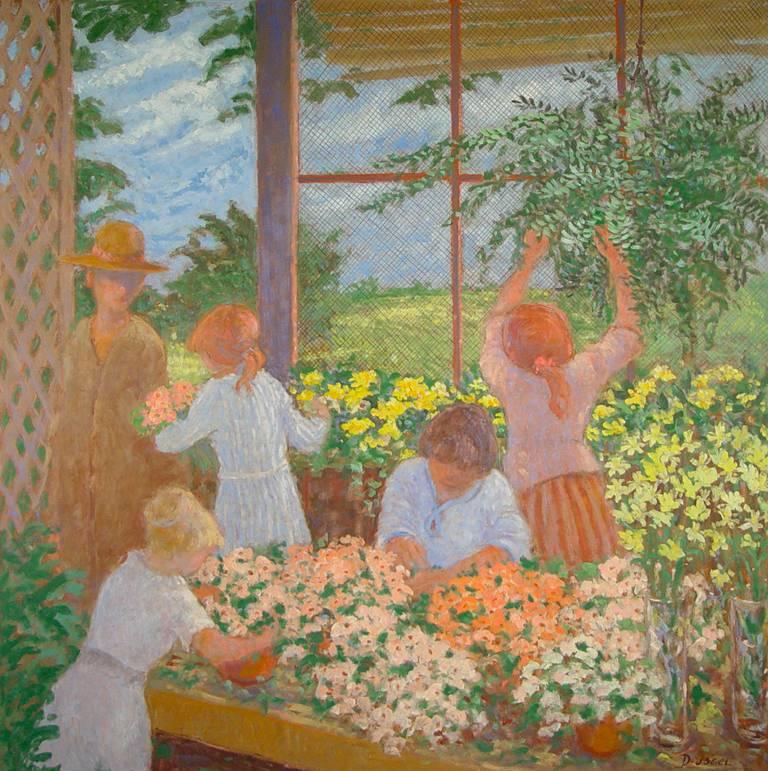Items Similar to Violinist in an Interior - British Impressionist 19thC art musical oil painting
Want more images or videos?
Request additional images or videos from the seller
1 of 19
William Christian SymonsViolinist in an Interior - British Impressionist 19thC art musical oil paintingCirca 1880
Circa 1880
About the Item
This superb British Impressionist 19th century oil painting is by noted artist William Christian Symons. Painted circa 1880 it is a figurative interior composition of a musical event. In the foreground of a drawing room a lady sits profile to the viewer, playing the violin, music stand with music in front of her. A young man stands by her side by the door. Beyond her a woman sits at a piano against the wall. The whole scene is softly illuminated by lamp lights on the piano, lighting up the wall above where objects can be seen. The female violinist is also beautifully illuminated, the light gleaming on her violin and music . The impressionistic brushwork on her yellow blouse and the piano area are just superb. The whole painting has a wonderful warm, cozy glow and is absolutely charming.
Provenance: Oxford estate.
Condition. Oil on canvas, 36 inches by 28 inches and in good condition.
Frame. Housed in a complementary frame, 43 inches by 35 inches and in good condition
William Christian Symons (1845-1911) was an English decorative designer, and a painter in oil and watercolour. Symons was the elder son of William Martyn Symons by his wife Elizabeth White. His father, who came originally from Trerice, St. Columb, Cornwall, carried on a printing business in Bridge Street, Vauxhall, where Christian, his second child, was born on 28 November 1845. There was one other son and two daughters. Symons was educated at a private school in Penzance until he was sent at an early age to the Lambeth Art School, then under the direction of the influential educationalist John Charles Lewis Sparkes. In 1866 he entered the Royal Academy as a student for a short while, gaining that year a silver medal in the antique school. In 1869 for the first time one of his works (a portrait of his sister) was hung at the Academy Exhibition, to which he was an intermittent contributor until the year of his death, when he was represented by an 'Interior of Downside Abbey'. His easel pictures were also shown at the New English Art Club, the Institute of Painters in Oil, and various other galleries. In 1870 he was received into the Roman Catholic church, and began his long connection with the firm of Lavers, Barraud and Westlake, for whom he designed a number of stained windows. Symons became a member of the Royal Society of British Artists in 1881, but seceded with James McNeill Whistler in 1888. He only came personally before the public in 1899, when he acted as secretary to the celebrated dinner organised in honour of Whistler on 1 May. In 1899 he began the execution of his commission for certain mosaic decorations at Westminster Cathedral, the work by which he was chiefly known until the posthumous exhibition of his paintings and watercolours at the Goupil Gallery in 1912. He worked at Newlyn in Cornwall for some time, and though never a member of the school associated with that locality he contributed an account of it to The Art Journal in April 1890. In later life he lived almost entirely in Sussex. He died at Udimore, near Rye, where he is buried, on 4 September 1911. He married at Hampstead in 1885 Cecilia, daughter of J. L. Davenport of Wildemlow, Derby. He left nine children. two daughters and seven sons, all of whom survived him. The eldest, Mark Lancelot (1887–1935), a painter of portraits and subject pieces, exhibited occasionally at the New English Art Club. His second son, Philip, became Dom Thomas Symons ARCO (1887–1975) of Downside Abbey and later of Worth Abbey, where he is buried. One of his best oil pictures, 'The Convalescent Connoisseur', is in the Dublin Municipal Gallery of Modern Art. In the Mappin Art Gallery at Sheffield are 'In Hora Mortis' and 'Home from the War', while 'The Squaw' belongs to the Contemporary Art Society. The British Museum, the Manchester City Art Gallery, and the Brighton Art Gallery possess characteristic examples of his watercolours. His flower pieces are of particular excellence. Mr. Le Brasseur of Hampstead possesses the largest collection of his paintings. Symons was obviously influenced by Sargent and Brabazon, but preserved his own individuality and did not allow his art to be affected by his friendship for Whistler.
- Creator:William Christian Symons
- Creation Year:Circa 1880
- Dimensions:Height: 43 in (109.22 cm)Width: 35 in (88.9 cm)Depth: 2 in (5.08 cm)
- Medium:
- Movement & Style:
- Period:
- Condition:
- Gallery Location:London, GB
- Reference Number:1stDibs: LU853114438842
About the Seller
5.0
Platinum Seller
These expertly vetted sellers are 1stDibs' most experienced sellers and are rated highest by our customers.
1stDibs seller since 2018
402 sales on 1stDibs
Typical response time: <1 hour
- ShippingRetrieving quote...Ships From: London, United Kingdom
- Return PolicyA return for this item may be initiated within 14 days of delivery.
More From This SellerView All
- Interior with Lady Reading - Scottish Edwardian 1910 art portrait oil paintingLocated in London, GBThis superb Scottish Edwardian Impressionist interior oil painting is by noted Scottish female artist Annie Rose Laing. Painted circa 1910, the composition is the interior of a room...Category
1910s Impressionist Interior Paintings
MaterialsOil
- Office Interior - British 1920's Slade School Jewish art oil paintingLocated in London, GBThis superb Impressionist figurative interior oil painting is by Slade School Jewish Victorian born artist Pyzer Cowen, previously Cohen. It was painted circa 1920 and entitled Fleet...Category
1920s Impressionist Interior Paintings
MaterialsOil
- Scottish Interior - Scottish 19th century Victorian art interior oil paintingBy George HayLocated in London, GBA fine Scottish Victorian interior scene by George Hay RSA. A very vibrant stunning Scottish historical interior painting which dates to about 1870. It depicts two women curtsying...Category
19th Century Victorian Figurative Paintings
MaterialsOil
- The Serving - British Old Master 18th century oil painting historical interiorBy (Circle of) William HogarthLocated in London, GBA superb British Old Master oil painting which is attributed to circle of William Hogarth and was painted circa 1760. This fine oil painting is in good clean condition and depicts a ...Category
18th Century Old Masters Figurative Paintings
MaterialsOil
- Christ Expelling Money Changers - British 30's surrealist art religious interiorBy Augustus LunnLocated in London, GBPainted by "Modern British" artist Augustus Lunn this oil/tempera on board depicts Christ Expelling the Money Changers. He exhibited widely at The Cooling Galleries and The New Engl...Category
20th Century Surrealist Figurative Paintings
MaterialsOil
- Cornish Family in an Interior - British 1912 Newlyn School art oil paintingBy Harold HarveyLocated in London, GBThis superb British figurative interior oil painting is by noted Newlyn school artist Harold Harvey. Painted circa 1912 the composition is a Cornish family, bathed in golden light, s...Category
1910s Realist Interior Paintings
MaterialsOil
You May Also Like
- The Goldfish BowlBy Richard Edward MillerLocated in New York, NYThe Goldfish Bowl by Richard Miller (1875-1943) Oil on canvas 37 ½ x 29 ¾ inches unframed (95.25 x 75.565 cm) 46 ⅝ x 36 ¼ inches framed (118.428 x 97.155...Category
Early 20th Century American Impressionist Figurative Paintings
MaterialsOil
- Early 20th century French oil, seated ballerina adjusting her ballet slipper.Located in Woodbury, CTVery Impressive French Impressionist figure study of a Ballerina seated in an interior. A very decorative and very desirable oil on canvas dating from the early 1900's The painting...Category
Early 1900s Impressionist Figurative Paintings
MaterialsCanvas, Oil
- Old Men with Kittens - Impressionist Oil, Figures in Interior by J F RaffaelliBy Jean-Francois RaffaelliLocated in Marlow, BuckinghamshireA wonderful oil on panel by French impressionist painter Jean-Francois Raffaelli depicting two old men seated in an interior. One is reading his paper as the other naps and there are several kittens on the floor. Painted in the artist's distinctive style. The work is accompanied by a certificate from Brame & Lorenceau and is included in the catalogue raisonne of the painter. Signature: Signed lower left Dimensions: Framed: 9.5"x8" Unframed: 5.5"x4" Provenance: Private collection - United States Original artists label verso Jean-François Raffaëlli's father was a failed Italian businessman and Raffaëlli himself was, among other things, a church chorister, actor and theatre singer. He then studied under Gérôme at the École des Beaux-Arts in Paris. He travelled to Italy, Spain and Algeria and on his return to France settled in Asnières. In 1876, on a trip to Brittany, he first saw the potential of realist subject matter, if treated seriously. He became involved in meetings of artists at the Café Guerbois, where the Impressionist painters used to gather. As a result, Degas, contrary to the advice of the group, introduced Raffaëlli to the Impressionist exhibitions - according to one uncertain source as early as the very first exhibition, at the home of Nadar, and certainly to those of 1880 and 1881. In 1904, Raffaëlli founded the Society for Original Colour Engraving. He first exhibited at the Salon de Paris in 1870 and continued to exhibit there until he joined the Salon des Artistes Français in 1881, where he earned a commendation in 1885, was made Chevalier of the Légion d'Honneur in 1889 and in the same year was awarded a gold medal at the Exposition Universelle. In 1906 he was made Officier of the Légion d'Honneur. He was also a member of the Société Nationale des Beaux-Arts. In 1884, a private exhibition of his work cemented his reputation. He contributed to several newspapers such as The Black Cat (Le Chat Noir) in 1885 and The French Mail (Le Courrier Français) in 1886 and 1887. He published a collection entitled Parisian Characters, which captured his favourite themes of the street, the neighbourhood and local people going about their lives. In 1880 he participated, with Forain, on the illustration of Joris Karl Huysmans' Parisian Sketches (Croquis Parisiens). He also illustrated Huysman's Works. As well as working as an illustrator, he also made etchings and coloured dry-points. His early attempts at painting were genre scenes, but once he was settled in Asnières he started to paint picturesque views of Parisian suburbs. From 1879 onwards, his subject matter drew on the lives of local people. These popular themes, which he treated with humanity and a social conscience, brought him to the attention of the social realist writers of the time such as Émile Zola. In addition to his realist style, Raffaëlli's dark palette, which ran contrary to the Impressionist aesthethic, helped to explain the opposition of those painters to his participation in their exhibitions. More concerned with drawing than colour, he used black and white for most of his paintings. Towards the end of his life, he lightened his palette, but without adopting any other principles of the Impressionist technique. After painting several portraits, including Edmond de Goncourt and Georges Clémenceau, he returned to genre painting, particularly scenes of bourgeois life. Later in his career, he painted mainly Breton-inspired sailors and views of Venice. His views of the Paris slums and the fortifications, sites which have almost completely disappeared, went some way towards establishing a genre in themselves and perpetuated the memory of the area: The Slums, Rag-and-Bone Man, Vagabond, Sandpit, In St-Denis, Area of Fortifications. His realistic and witty portrayal of typical Parisian townscapes accounts for his enduring appeal. Born in Paris, he was of Tuscan descent through his paternal grandparents. He showed an interest in music and theatre before becoming a painter in 1870. One of his landscape paintings was accepted for exhibition at the Salon in that same year. In October 1871 he began three months of study under Jean-Léon Gérôme at the École des Beaux-Arts in Paris; he had no other formal training. Raffaëlli produced primarily costume pictures until 1876, when he began to depict the people of his time—particularly peasants, workers, and ragpickers seen in the suburbs of Paris—in a realistic style. His new work was championed by influential critics such as J.-K. Huysmans, as well as by Edgar Degas. The ragpicker became for Raffaëlli a symbol of the alienation of the individual in modern society. Art historian Barbara S. Fields has written of Raffaëlli's interest in the positivist philosophy of Hippolyte-Adolphe Taine, which led him to articulate a theory of realism that he christened caractérisme. He hoped to set himself apart from those unthinking, so-called realist artists whose art provided the viewer with only a literal depiction of nature. His careful observation of man in his milieu paralleled the anti-aesthetic, anti-romantic approach of the literary Naturalists, such as Zola and Huysmans. Degas invited Raffaëlli to participate in the Impressionist exhibitions of 1880 and 1881, an action that bitterly divided the group; not only was Raffaëlli not an Impressionist, but he threatened to dominate the 1880 exhibition with his outsized display of 37 works. Monet, resentful of Degas's insistence on expanding the Impressionist exhibitions by including several realists, chose not to exhibit, complaining, "The little chapel has become a commonplace school which opens its doors to the first dauber to come along."An example of Raffaëlli's work from this period is Les buveurs d'absinthe (1881, in the California Palace of Legion of Honor Art Museum in San Francisco). Originally titled Les déclassés, the painting was widely praised at the 1881 exhibit. After winning the Légion d'honneur in 1889, Raffaëlli shifted his attention from the suburbs of Paris to city itself, and the street scenes that resulted were well received by the public and the critics. He made a number of sculptures, but these are known today only through photographs.[2] His work was also part of the painting event in the art competition at the 1912 Summer Olympics. In the later years of his life, he concentrated on color printmaking. Raffaëlli died in Paris on February 11, 1924 Museum and Gallery Holdings: Béziers: Peasants Going to Town Bordeaux: Bohemians at a Café Boston: Notre-Dame; Return from the Market Brussels: Chevet of Notre-Dame; pastel Bucharest (Muz. National de Arta al României): Market at Antibes; Pied-à-terre Copenhagen: Fishermen on the Beach Douai: Return from the Market; Blacksmiths Liège: Absinthe Drinker...Category
1890s Impressionist Figurative Paintings
MaterialsPanel, Oil
- Daumier French Impressionist Museum Interior Women Framed Cool Colors Blue PinkBy Jean DaumierLocated in Buffalo, NYAn original oil on canvas painting by French artist Jean Daumier (b. 1948). This endlessly charming work depicts three young women inside a museum in the artist's signature style, ...Category
1970s Impressionist Figurative Paintings
MaterialsOil, Canvas
- Greenhouse in BloomBy Donald S. VogelLocated in Dallas, TXThe greenhouse became a favorite subject of Donald Vogel's in the 1980's. As Vogel reflected in the 1998 catalogue published for his traveling retrospective exhibition, "The greenhou...Category
1970s American Impressionist Figurative Paintings
MaterialsOil
- Flower ShedBy Donald S. VogelLocated in Dallas, TXThe greenhouse became a favorite subject of Donald Vogel's in the 1980's. As Vogel reflected in the 1998 catalogue published for his traveling retrospective exhibition, "The greenhou...Category
Late 20th Century American Impressionist Figurative Paintings
MaterialsOil, Panel
Recently Viewed
View AllMore Ways To Browse
Antique Contemporary Art
Cozy Art
Friendship Art
Antique Home Interior Design
Art Against War
Antique Paintings Pictures
Antique Oil Can Collection
Catholic Art
An Example Of Art By A Female Artist
Modern Christian Art
Catholic Painting
Early Christian Art
Antique Journal
19th Century Impressionist Oil In Canvas
1881 Oil Paintings
Antique British Oil Painting
Painting Antique Windows
Antique Door Painting



